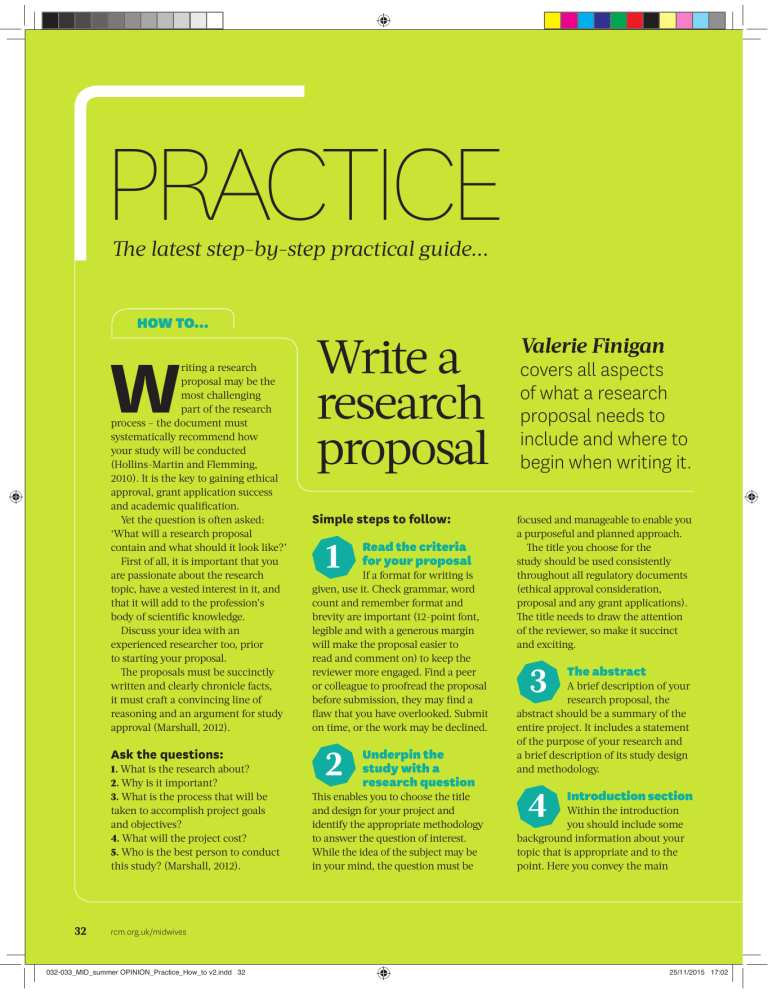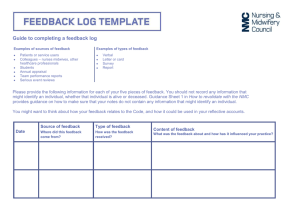
PRACTICE The latest step-by-step practical guide... HOW TO... W riting a research proposal may be the most challenging part of the research process – the document must systematically recommend how your study will be conducted (Hollins-Martin and Flemming, 2010). It is the key to gaining ethical approval, grant application success and academic qualification. Yet the question is often asked: ‘What will a research proposal contain and what should it look like?’ First of all, it is important that you are passionate about the research topic, have a vested interest in it, and that it will add to the profession’s body of scientific knowledge. Discuss your idea with an experienced researcher too, prior to starting your proposal. The proposals must be succinctly written and clearly chronicle facts, it must craft a convincing line of reasoning and an argument for study approval (Marshall, 2012). Ask the questions: 1. What is the research about? 2. Why is it important? 3. What is the process that will be taken to accomplish project goals and objectives? 4. What will the project cost? 5. Who is the best person to conduct this study? (Marshall, 2012). 32 Write a research proposal Simple steps to follow: 1 Read the criteria for your proposal If a format for writing is given, use it. Check grammar, word count and remember format and brevity are important (12-point font, legible and with a generous margin will make the proposal easier to read and comment on) to keep the reviewer more engaged. Find a peer or colleague to proofread the proposal before submission, they may find a flaw that you have overlooked. Submit on time, or the work may be declined. 2 Underpin the study with a research question This enables you to choose the title and design for your project and identify the appropriate methodology to answer the question of interest. While the idea of the subject may be in your mind, the question must be Valerie Finigan covers all aspects of what a research proposal needs to include and where to begin when writing it. focused and manageable to enable you a purposeful and planned approach. The title you choose for the study should be used consistently throughout all regulatory documents (ethical approval consideration, proposal and any grant applications). The title needs to draw the attention of the reviewer, so make it succinct and exciting. 3 The abstract 4 Introduction section A brief description of your research proposal, the abstract should be a summary of the entire project. It includes a statement of the purpose of your research and a brief description of its study design and methodology. Within the introduction you should include some background information about your topic that is appropriate and to the point. Here you convey the main rcm.org.uk/midwives 032-033_MID_summer OPINION_Practice_How_to v2.indd 32 25/11/2015 17:02 Midwives / Winter 2015 Practice READ ON EBM 8 Provide a timeline Finish with a request for ethical approval to allow you to conduct the research. Ethical approval has the remit of protecting the dignity and rights of participants and of facilitating ethically sound research (Manning, 2004). It is important that you conduct the study in accordance with the organisation’s local research policies and governance procedures. Don’t forget to thank the committee and academic teams for their time and consideration. Dr Valerie Finigan, midwife, Pennine Acute NHS Hospital Trust w mp ei th lica t io n s Identif y th ep ro bl em C ho SIMPLE STEPS TO WRITING A RESEARCH PROPOSAL na lys et he ose the method Produce a flowchart that gives an overview of the entire project and demonstrates how different parts of the study interconnect to produce the end results – a unique contribution to the evidence base. This will determine if the study can be completed 9 A Methods refer to the ‘techniques or procedures used to gather and analyse data related to the research question or hypotheses’ (Jonker and Pennink, 2010; HesseBiber and Leavy, 2008). Methodology outlines the sample, setting, procedures, materials, data collection and description, human subjects, institutional review and consent forms. In essence, the methodology is the blueprint of the study, where each aspect of the research design is described in sequence. The chosen methodology must be the best formula to answer the research question and must be coherent with the researcher’s theoretical perspective (Dykes, 2004). Research methodology can be selected from two areas, either quantitative (deductive) or qualitative (inductive). Both approaches are appropriate within maternity care, as both have strengths and weaknesses; they can be used simultaneously in a study with both methods being conducted Conclude the proposal ar ch 6 The methodology Conduct an extended and comprehensive literature review to provide a rationale for the study. Assess primary and secondary sources of literature and include ‘grey’ literature where appropriate. The work of other researchers can underpin your proposal, identifying the current limitations of knowledge and demonstrating the benefits your study can offer. No topic is entirely new, it may be your approach or the angle that makes your study unique. The review should be timely, relevant, directly relate to the study and: Help you to find out what is already known about the subject area See what methodology and methods other researchers have used to answer similar questions Help you to refine your research question, choosing an appropriate research strategy Enable you to develop a theoretical framework to underpin your research. se The goal is the broad statement describing what it is hoped will be accomplished as a result of the research. The objective is the more specific statements that describe the detailed outcomes of the study, which can be measured qualitatively, quantitatively, or by both methods. 7 Positioning the research in the allotted time for your academic institution or funding body. If you meet challenges on the way, don’t be afraid; make them clear, refashion the plan, identify alternative approaches that enable you to achieve your goals. Remember, research is a journey; a time in which the researcher and researched learn from each other. Re vie 5 Outline the goal and objectives in the same rigorous, systematic and transparent manner (Dykes, 2004). are the findings Prep idea of your research and why the systematic inquiry is important. Define the significance of the study to the population it has relevance for; such as midwifery, health care, policy-makers, and commissioners. data t ut yo Carr he re rcm.org.uk/midwives 032-033_MID_summer OPINION_Practice_How_to v2.indd 33 33 25/11/2015 17:02 Copyright of Midwives is the property of Redactive Publishing Ltd. and its content may not be copied or emailed to multiple sites or posted to a listserv without the copyright holder's express written permission. However, users may print, download, or email articles for individual use.
![Letter to MPs re: maternal mental health report Dear [Name of MP] I](http://s3.studylib.net/store/data/006839335_1-7d7b3127aade7ad6d126565942ce75c1-300x300.png)


